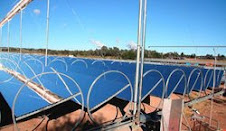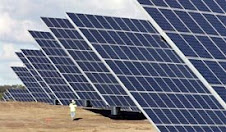Eureka, California [RenewableEnergyAccess.com] Plans are underway in northern California for a project that would combine three renewable energy resources -- one wind power, one biomass and one ocean energy project -- all into one interconnected project.
The public was given an opportunity to identify issues to be addressed as the project develops in a public forum hosted last month by the Redwood Coast Energy Authority (RCEA) on the proposed Fairhaven Tri-Renewable Energy Park project, recently announced by the CEO of DG Energy Solutions CEO Steve Mueller.
This project, which Mueller said is the first in the world to combine three renewable energy technologies in one location, is hoped to augment an existing 18 megawatts (MW) of biomass-fueled electrical generating capacity at the DG Fairhaven biomass plant on the Samoa Peninsula by adding 20 MW of wind-generated energy and 20 MW of wave generated energy. DG Energy is the parent company of the DG Fairhaven biomass plant, which has been producing local renewable energy since 1986.
According to DG Energy Solutions, this project will include a field of Ocean Power Technology power buoys tethered to the ocean floor approximately 4,500 feet offshore from its Fairhaven facility. Each power buoy will produce up to 500 kilowatt hours (kWh) of electricity in average ocean conditions. The project will also include ten 2 MW wind turbines located on the Fairhaven property and adjacent parcels. The energy produced by this project will interconnect with PG&E transmission lines using existing substations on the peninsula.
"The prospect of locally producing upwards of 58 MW of clean, sustainable, renewable energy is very exciting," said David Boyd, RCEA's Executive Director. The Draft Energy Element recently prepared for the County by RCEA identified the need for Humboldt County to increase its local renewable energy capacity in order to meet future energy demand. According to Boyd, peak electricity demand in Humboldt County is about 158 MW, so this project could meet more than one third of Humboldt's present power needs.
"As promising as the Tri-Renewable project appears, considering its possible impacts to the coastal environment, it deserves a careful review," said Boyd. To further dialogue on this project, RCEA invited key stakeholders from public agencies, community groups, and environmental organizations to the forum.
Best Green Stocks Investing Blog
Subscribe to:
Post Comments (Atom)
Yuya Joe Blog
Lake Ontario Waterkeeper
The Daily Beast -Politics Blog
21stArch.com - 21st Century Architecture
Original Joe College Blog
WikiLeaks Foreign Policy Analysis
AGreenRealtor.com Real Estate Blog - Ecology Energy Efficiency
Best Green Stocks Investing Blog
PV Intell Photovoltaic Solar Stocks Investing
SEARCH Leading Alternative Energy and Ethical Investing websites

Custom Search
Daily Kos
Rare Earth Stocks Research
Patrick MacManus's Blog Peace and Collaborative Development
BeesTreesFrogsElephants.com - Nature and Ecology Blog
Research Green Energy stocks, Clean Energy investing information
Find wind power investing info online, clean energy mutual funds, geothermal stocks, solar energy investments.

Green Energy Investing Network:
Green Stocks Investing Clean Power Blog
SolarIntell.com Renewable Power Investing Website
Wind Intell.com Wind Energy Stocks Company Links
Geothermal Power Investing Public Companies
PV Intell.com Leading Photovoltaic Solar Energy Stocks

Custom Search
Green Energy Investing Network:
Green Stocks Investing Clean Power Blog
SolarIntell.com Renewable Power Investing Website
Wind Intell.com Wind Energy Stocks Company Links
Geothermal Power Investing Public Companies
PV Intell.com Leading Photovoltaic Solar Energy Stocks







No comments:
Post a Comment